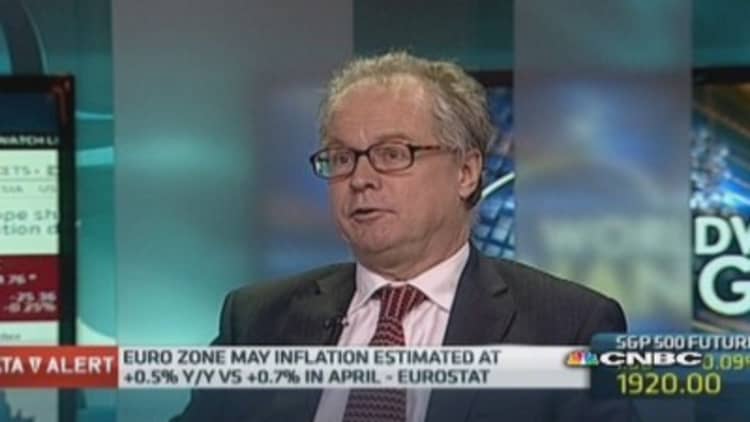Euro zone inflation slid back once again in May, piling yet more pressure on the European Central Bank (ECB) to act and ward off the risk of deflation.
Consumer prices rose by 0.5 percent year-on-year in May, according to official statistics released by Eurostat Tuesday. This marked a fall from April's 0.7 percent, and was below the 0.7 percent expected by analysts polled by Reuters.

Inflation of 0.5 percent was also recorded in March; before this, it was last at this level in November 2009.
Read MoreAll eyes on the ECB: Negative rate looms
The figure means inflation is still significantly below the ECB's target of close to 2 percent, and will lead to increased calls for the ECB to act in an effort to boost the region's economy when its Governing Council meets this Thursday.
Fears that the 18-country currency bloc was sliding towards deflation were ignited when inflation fell to a 47-month low of 0.7 percent in October and the central bank cut interest rates to a record low of 0.25 percent in response.
Since then, price growth has continued to disappoint, and ECB President Mario Draghi is widely expected to unveil stimulus measures this week as a result.
Read MoreDraghi's Toolbox: Bond-buying bazooka on the way?
"The ECB hardly needs any more reason to deliver a major package of stimulative measures at its June policy meeting on Thursday to counter the risk of prolonged very low inflation turning into deflation," Howard Archer, chief European economist at IHS Global Insight, said in a note.
"But if the ECB was at all unsure of the need for strong action then the dip in euro zone consumer price inflation to just 0.5 percent in May surely gave the Governing Council a final shove towards cutting interest rates and also announcing liquidity measures."
Economists are split over what form ECB stimulus will take, however. Many are expecting a rate cut to both the refinancing rate and the deposit rate - which would take the latter into negative territory - and some additional liquidity measures.
Jennifer McKeown, senior European economist at Capital Economics, however, argued that some form of a bond-buying, or quantitative easing (QE), programwould ultimately be needed.
"While the ECB looks set to cut interest rates and announce some lending incentives after its meeting this Thursday, we think that it will ultimately need to implement a large scale quantitative easing program to counter the growing risk of deflation," she wrote in a note.
Unemployment falls
Meanwhile, separate figures published by Eurostat Tuesday revealed that unemployment in the euro zone met expectations in April. Joblessness fell to 11.7 percent in April from 11.8 percent in March, although McKeown said this rate remained "worryingly high".
Austria and Germany had the lowest unemployment rates, at 4.9 percent and 5.2 percent respectively, while Greece and Spain's remained the highest, at 26.5 percent and 25.1 percent.
Jobless among those under the age of 25 remained high, at 23.5 percent in the euro zone in April. Greece and Spain also had the highest youth unemployment rates, at 56.9 percent and 53.5 percent respectively.


